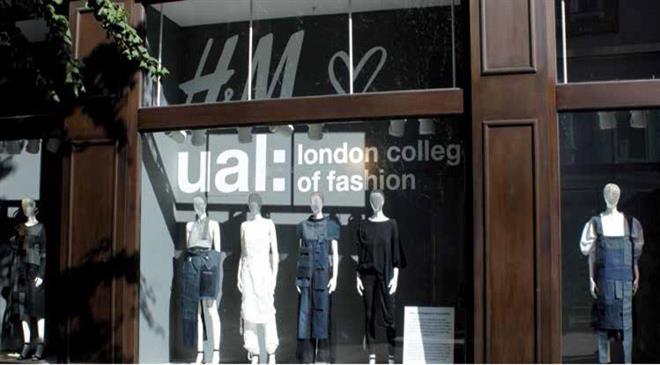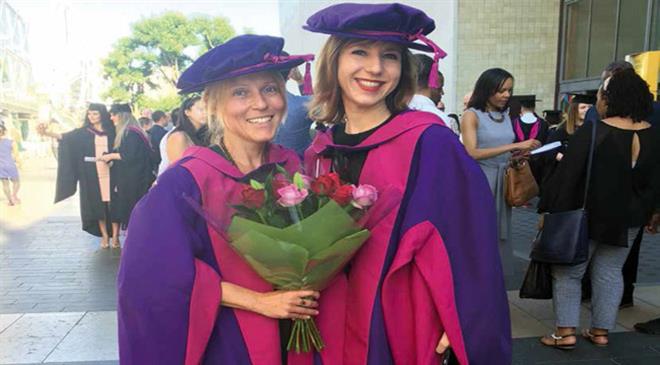We need a complete shift of the system
The Centre for Sustainable Fashion (CSF) at the London College of Fashion connects research, education and business to support, inspire and create innovative approaches to fashion. Established in 2008 by Dilys Williams, the CSF's starting point was human and ecological resilience as a lens for design in fashion's artistic and business practices. Williams, who is Professor of Fashion Design for Sustainability and Director at the Centre for Sustainable Fashion, University of the Arts in London, delves deep into the issues of sustainability in fashion with Subir Ghosh
The Centre for Sustainable Fashion is in its tenth year now. How much do you think the centre has been able to have an impact on the discourse about sustainable fashion itself? Have you been following any metrics towards this?
Over the last ten years, the Centre for Sustainable Fashion at London College of Fashion, UAL has worked to challenge the status quo in relation to our cultural, economic, social and educational practices in and through fashion. We are proud to say that we have broken new ground in each of these spheres and we've been able to take a leadership role in setting agenda on sustainability in fashion with businesses and government. We are not alone in these efforts, and through our partnerships we recognise progression in the discourse around sustainable fashion that has taken place over recent years. We set up the first research centre in the world dedicated to fashion and sustainability, and our research now has international readership.
The discipline of fashion design for sustainability is now well established and as researchers, we are now invited to headline conferences where this discipline was not considered ten years ago. We also set up the first MA course in Fashion and Sustainability (MA Fashion and the Environment, renamed MA Fashion Futures in 2015). Ten years of alumni tell us that there are new, exciting roles for these graduates, in industry, in NGOs, in academia, in setting up social enterprises, etc.
We have also partnered with some of the world's biggest fashion businesses, including Nike and H&M to explore how their design teams and their customers can engage in cultures of sustainability. We have pioneered a unique partnership with Kering-one of the world's leading global luxury groups-to co-create curriculum which will have a demonstratable impact on the way that both business and education innovate. There has been an increasing number of graduates, fashion startups and SMEs who are interested in sustainability-we have worked with and mentored over 100 in the UK and this is now extending internationally.
Since 2011, we have worked with Baroness Lola Young and provided secretariat for an All-Party Parliamentary Group on Ethics and Sustainability in Fashion (APPG), and now we have started to see impact through the enactment and continued development of the Modern Slavery Act 2015. Global events like the Copenhagen Fashion Summit, to which we are the academic partner, demonstrate how far the industry has come over the past ten years. There is, however, a huge journey still to be undertaken if we are to find ways to live well with each other and with nature.

Very broadly, sustainability (especially w.r.t fashion) is a lifestyle issue. Convincing governments and industry might in fact be easier to do than bring about lifestyle changes among billions around the world. Your comments, please.
Sustainability is a cultural, economic, social and educational issue. It is an issue of our understanding of being human. It is an issue of world view-what is of value. Nature is the source of all of fashion's materials and indeed the vital element of which we are all a part. However, dominant scientific thought offers the view of humans as able to shape nature. We are part of a huge cultural revolution, where our understanding of ourselves in the world is changing. This will take decades or more to truly re-shape society and culture. We need to simultaneously create new cultures, new business practices, new legislation and new education.
We find ways to work on all of these agendas simultaneously, but as fashion is a very important cultural indicator, our ability to change culture through fashion is exciting. Through projects such as Craft of Use (Kate Fletcher), we investigate how people engage with garments in their day to day lives and the psychology around why people consume fashion (Project Transfer, Helen Storey)-so that we can understand how to inform better cultures of care through fashion. Through I Stood Up (Williams) people engage in discourse about their concerns, values and hopes through fashion.
Change in legislation and industry practice is intrinsically linked and critical to creating lifestyle change on a large scale. Fashion is an incredibly powerful communicator of self and collective expression, but there are currently around 150 billion fashion products being produced and marketed each year-and there is a large gap between where the majority of these products are consumed and where the majority of their environmental and social impacts are being felt. The intention of business must consider long as well as short term, which needs to be supported by legislation and culture.

Do you think sustainability initiatives are still quite sporadic/scattered all around the world? There is so much extraordinary work being done all over, after all.
It is great to see sustainability initiatives happening all over the world - there is much we can learn from each other and it is important we try and find ways to communicate and share as there is no one solution that will solve the greatest challenges the industry faces. There are organisations which are bringing networks and initiatives together, via the UN, NGOs such as Greenpeace, etc-but perhaps the most valuable way we can contribute to transformation is through education and ensuring the next generation of fashion practitioners have the skills and capabilities they need to create change. We hosted an Academic Leaders Roundtable at the Copenhagen Fashion Summit to discuss sustainability in global fashion education, looking at how students, tutors and heads of college can share with each other. We hosted a summit in 2008 to bring educators, businesses, NGOs and others together to share and take forward fashion and sustainability actions. In 2018, we will host a global fashion conference, inviting researchers and businesses from across the world to speak. Select papers will be published-details to follow shortly. We are also planning a number of initiatives which will be announced later this year which will make accessing education on this subject much easier, including an open source course.
One of the key factors that the CSF mentions on its website is "create internationally acclaimed research". How much do you think this has happened in the last ten years or so? Do you think the volume of research is not that voluminous enough? Especially given the fact that the fashion/apparel supply chain is so long-winding, and the spread of the industry is so far and wide?
Our starting point for research is contributing to the field of design for sustainability-the uniqueness of the centre is that it brings together a diverse community of voices and perspectives to develop both theoretical and practice based knowledge that contributes to this field. Through our research we explore fashion in relation to key themes such as questioning consumption and growth, usership, social change and amplifying public understanding of climate change. We cannot and do not attempt to cover everything to do with fashion and sustainability- instead we work with other institutions and academics who focus on complimentary areas. Over the past ten years, the centre's research has: produced leading books and publications (Kate Fletcher, Sandy Black) on fashion design and sustainability; developed practice based explorations of sustainability (Dress for Our Time, I Stood Up, Antarctica); and contributed to development of fashion education for sustainability and participatory design practice (Dilys Williams, Kering Partnership, Shared Talent).
Agenda-setting too is one of the key areas of the Centre for Sustainable Fashion. What do you think have been your major successes on this front?
All the more so, given the fact that a policy of one government/country can have a bearing on a number of others. And where do you think a lot of work needs to be done? The APPG's work with Lola Young and the Modern Slavery Act is an example of the importance of working with government, but there is still more work to be done as we need to understand if and how the Act has changed industry practice. We are currently undertaking research to see how the act has impacted fashion buying practices in the UK so that we can report back to parliament and inform continued amendments. Agenda setting covers industry and education too, as changes made in these arenas have global impacts. Our membership of the Sustainable Apparel Coalition (SAC) means that we are able to cross cultural, geographic and scale boundaries in exploring design practices in fashion and changing education is possibly one of the biggest changes in agenda that we can make-changing how the next generation of fashion professionals, see, know and do their work.

How do you think brands and associations can weave in the Sustainable Developments Goals (SDGs) into both their respective visions and strategies? Both the goals and the targets of the SDGs are not that easy to translate into fashion tangibles.
We are seeing more and more brands and associations referring to the SDGs and embedding them into their sustainability strategies-how this is linked to the core business/financial strategy is less evident, although Kering's environmental profit and loss (EP&L) has started the conversation. Although the SDGs might seem too big and detached from the everyday practice of fashion, many of them have direct relevance-and it is up to each individual business to determine which SDGs are most relevant to them. For example, a denim company, relying on cotton may decide that their business activities particularly relates to SDG 6 (Access to clean water) so will strive to decrease water use and water pollution. Then there are specific goals which should be adopted by all fashion businesses-SDG 8 (Decent work for all) and SDG 12 (Responsible consumption and production).
Last, do you think ecological degradation is taking place at a rate that is faster than that at which sustainability initiatives are able to cope with?
Absolutely. Unfortunately, the many good initiatives taking place are greatly outweighed by the speed at which we are producing and consuming fashion. There has been a strong focus from industry and government on technological solutions that aim to reduce the 'impact', and whilst the results are often innovative it is not enough to prevent ecological and social degradation at the scale we need. Tweaks to make the industry more effective are not enough, we need a complete shift of the system-and this systems change means making change in each of our lives, in business, in government, in education. We are the first generation to really understand this imperative and we are equipped with the will and the skill to live well together, if we really want to.
Last year, you wrote an article in the Huffington Post titled 'Why Fashion Needs a New Direction'. How important is it to make course corrections in the road to a sustainable future? Could you give us a couple of examples wherein you felt the need to change something about the way the Centre had been functioning?
CSF has grown a lot over the last ten years, with contributions from different team members, partners and a variety of exciting projects. Whilst our overall ambition remains the same, we continue to test, try and evaluate the impact of our work across research, knowledge exchange and education. The strength of the centre's work comes from the combination of the skills and experience from all of its members-this means allowing the space for everyone to have a voice. We continually try to work/live by our values-work collaboratively and transparently, but also consider who we partner with and why. We are all constantly learning and we need to reflect on our actions as we go, always ready to recentre ourselves. The steady element of our work is the intention for fashion to contribute to living within planetary boundaries and human equity-what we do and how we get there needs critical thinking.




